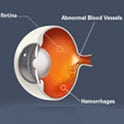 Diabetes attacks the small blood vessels of the entire body. When the blood sugar is not well controlled it can damage blood vessels in the back of the eye (the retina). These blood vessels can leak fluid and cause swelling. They can also become too weak to supply the proper amount of oxygen and nutrients to the retina. There are two types of diabetic retinopathy. The most common is nonproliferative diabetic retinopathy. This form ranges from mild to severe and can progress into proliferative diabetic retinopathy. This form involves new blood vessel growth (neovascularization) of the retina. These vessels are extremely weak and grow in irregular patterns. The blood vessels leak and produce scar tissue that has the potential to cause severe vision loss. Excellent blood glucose control has been proven to lower the chance of diabetic retinopathy.
Diabetes attacks the small blood vessels of the entire body. When the blood sugar is not well controlled it can damage blood vessels in the back of the eye (the retina). These blood vessels can leak fluid and cause swelling. They can also become too weak to supply the proper amount of oxygen and nutrients to the retina. There are two types of diabetic retinopathy. The most common is nonproliferative diabetic retinopathy. This form ranges from mild to severe and can progress into proliferative diabetic retinopathy. This form involves new blood vessel growth (neovascularization) of the retina. These vessels are extremely weak and grow in irregular patterns. The blood vessels leak and produce scar tissue that has the potential to cause severe vision loss. Excellent blood glucose control has been proven to lower the chance of diabetic retinopathy.



